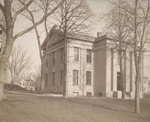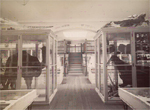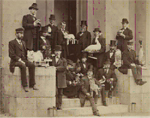Rhode Island Hall: Our Home
To accommodate its growing faculty and student body and to reflect its central importance to Brown University’s academic mission, the Joukowsky Institute moved to Rhode Island Hall, on Brown’s Main Green, in September 2009.
Rhode Island Hall, the fourth oldest building on the main green, has seen a variety of occupants since its construction in 1840. It was originally built as “another College edifice for the accommodation of the Departments of Natural Philosophy, Chemistry, Mineralogy, Geology, and Natural History” (letter from Nicholas Brown to the Corporation, March 18, 1839), and was largely funded by donations from wealthy Rhode Islanders — explaining the building’s name. The science departments had an extensive collection of taxidermy and osteological specimens, which were displayed, in the Museum of Natural History, located on the second floor of Rhode Island Hall. This collection was built up and overseen by Professor J.W.P. Jenks, one of the most colorful characters in the history of Brown University. Jenks conducted voluntary taxidermy classes in the east room of the basement, and eventually met his demise on the very steps of the building in 1894. Walter Lee Munroe recorded that he “stopped for a minute in conversation on the steps of Rhode Island Hall, started to go upstairs to the Museum, sank down and expired without a moment’s sickness or suffering. One could not ask for a finer end.”
One could not ask for a finer end.”
The building continued to be occupied by Biology until 1915, and the Department of Geological Sciences until 1982. However by the 1970s the department had expanded significantly and it was widely felt that the building was ill-equipped for a modern scientific discipline. In 1982 Geology moved out and Rhode Island Hall became a highly fragmented, multi-purpose space. Until Fall 2009, for example, Rhode Island Hall housed a set of eclectic occupants including the Office of International Programs, the Writing Fellow’s Center, the Wayland Collegium for Liberal Learning, and Psychological Services.
When the Joukowsky Institute for Archaeology and the Ancient World was founded in 2004, Rhode Island Hall was assigned to be its new home,  thus marking a very strong commitment to the study of archaeology on the part of the University administration and faculty. The building, in somewhat parlous state, needed complete gutting and renovation.
thus marking a very strong commitment to the study of archaeology on the part of the University administration and faculty. The building, in somewhat parlous state, needed complete gutting and renovation.
From the beginning of this renovation process, the ‘user community’ of the Joukowsky Institute for Archaeology and the Ancient World was consulted and involved on all major decisions about the building’s program and priorities. Space for teaching, for research, for quiet thinking, and for kitchen chatting are all built into the structure. At every turn, our intention has been to provide a welcoming and stimulating environment for scholarship and community: a building in which deep deliberation can take place and serious fun can be had.
The building contains faculty and staff offices,  a lecture hall, a seminar room, and a non-circulating library of relevant books and journals. A small study collection of artifacts (including pottery, metalwork, and figurines) and a substantial numismatic collection are also housed in secure storage here; these are available for student teaching and research. Graduate students in the Joukowsky Institute are provided with study space, as well computing and scanning facilities. A fieldwork laboratory has computer facilities and space for analysis and study. Finally, a comfortable Common Room and other places to study, research, and relax are available for use by the entire Institute community.
a lecture hall, a seminar room, and a non-circulating library of relevant books and journals. A small study collection of artifacts (including pottery, metalwork, and figurines) and a substantial numismatic collection are also housed in secure storage here; these are available for student teaching and research. Graduate students in the Joukowsky Institute are provided with study space, as well computing and scanning facilities. A fieldwork laboratory has computer facilities and space for analysis and study. Finally, a comfortable Common Room and other places to study, research, and relax are available for use by the entire Institute community.
View a video about Rhode Island Hall and the Joukowsky Institute, made for the dedication of the building in 2009:
Rhode Island Hall (Udris Productions, 2009)
